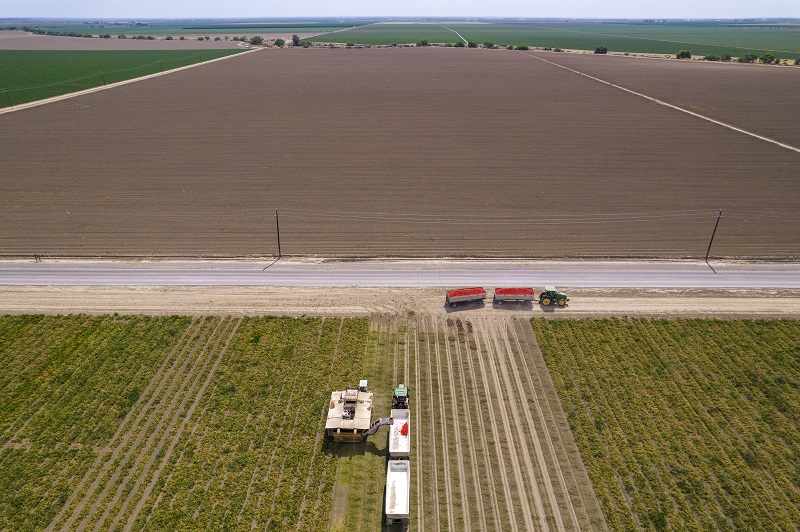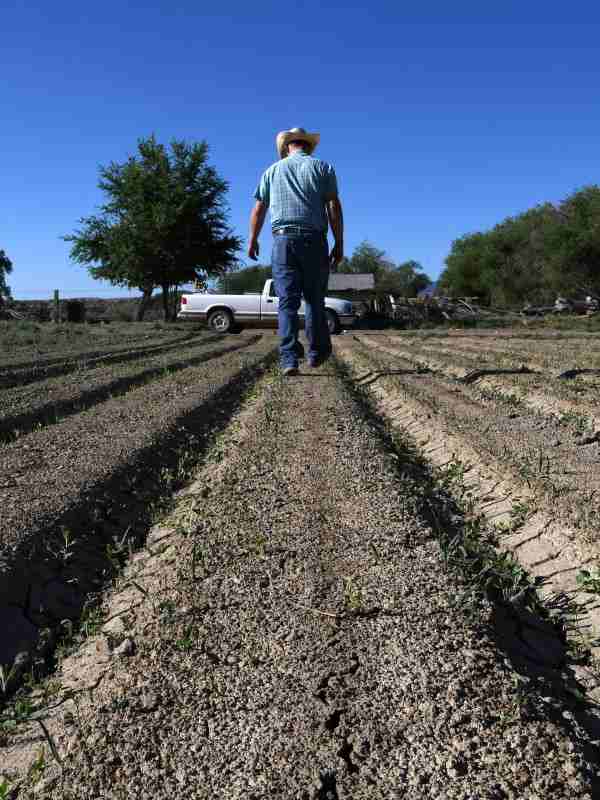U.S. announces more water cuts as Colorado River hits dire lows

Tomatoes are harvested in the San Joaquin Valley of California across the road from a field that was fallowed due to water shortages.
11:10 JST, August 17, 2022
As the historic drought in the U.S. Southwest pushes the nation’s largest reservoirs to record lows, the Biden administration Tuesday announced that water shortages along the Colorado River had passed a threshold for the first time that will require unprecedented water cuts in Arizona and Nevada.
But the federal government left unresolved the looming question of how seven Western states will divide what’s left of the dwindling river in the years ahead. Those states blew past Monday’s deadline, set by the U.S. Bureau of Reclamation in June, to reach a voluntary agreement on how to reduce water use by 2 million to 4 million acre-feet – up to a third of the river’s annual average flow.
Deputy Interior Secretary Tommy Beaudreau on Tuesday told reporters there was “still time” to find consensus, and Reclamation officials did not say when they might impose their own cuts if no deal is reached.
The announcement underscored both how dire drought conditions have become in the Colorado River basin and the challenge of getting competing states to cut vital water supplies that sustain cities, agriculture and hydropower for millions of people.
The Colorado River’s decline has drained three-quarters of the water from the nation’s largest reservoirs, and falling closer than ever to levels where hydroelectric dams can’t generate power and millions will lose access to drinking water and irrigation supplies. By declaring Tuesday that the Lower Colorado River Basin has reached what’s called a “Tier 2” shortage, the bureau is requiring cuts in water use that will diminish what Arizona gets by 21%, Nevada by 8% and the country of Mexico by 7%.
“The system is approaching a tipping point, and without action we cannot protect the system and the millions of Americans who rely on this critical resource,” M. Camille Calimlim Touton, commissioner of the Bureau of Reclamation, said during a news conference. “Protecting the system means protecting the people of the American West.”
There are designated supplies for Upper Basin states (Colorado, Wyoming, Utah and New Mexico) and Lower Basin states (California, Nevada and Arizona) as well as Mexico, where the river ends in the Sea of Cortez. State officials from both regions have expressed frustration in recent days with negotiations on curbing water use.
Colorado officials have said they’re looking for the Lower Basin to do more, while Arizona Department of Water Resources Director Tom Buschatzke on Tuesday called it “unacceptable” his state must “continue to carry a disproportionate burden of reductions for the benefit of others who have not contributed.”
“Through our collective inaction, the federal government, the basin states and every water user on the Colorado River is complicit in allowing the situation to reach this point,” John Entsminger, general manager of Southern Nevada Water Authority, wrote in a letter this week to Interior Secretary Deb Haaland.
The root of the problem is an ongoing, 23-year drought, the worst stretch for the region in more than a millennium. Snowpack in the mountains that feed the 1,450-mile river has been steadily diminishing as the climate warms. Ever-drier soils absorb runoff before it can reach reservoirs, and more frequent extreme heat hastens evaporation.
“The prolonged drought afflicting the West is one of the most significant challenges facing our communities and our country,” Beaudreau said. “The growing drought crisis is driven by the effects of climate change, including extreme heat and low precipitation.”
In searching for a solution, state officials say they are seeking to balance both short-term needs to save Lakes Mead and Powell from dipping too low, and also set themselves up for a longer-term agreement where everyone will have to find ways to use less water because climate change has made the West hotter and drier.
“What we’re facing here is that continued drawdown at Powell and Mead starts to affect people’s physical ability to get water,” said Deven Upadhyay, assistant general manager and chief operating officer of the Metropolitan Water District of Southern California, a major urban water provider that gets a quarter of its supply from the Colorado River.
“It’s not like we can argue over this forever, and then the reservoir goes dry and you don’t have access to water, and at that point you’re not negotiating anything,” he said. “That is a powerful driver that is very different about these discussions now.”
But balancing the demands of so many states, cities, tribes and farmers is no easy task. The Colorado River was divided up a century ago, and within those broad outlines there is a tangled web of junior and senior water rights, outdated allocations and inequities that originally left Native Americans out of the equation.
Entsminger, of the Southern Nevada Water Authority, said that negotiations over the past two months have “produced exactly nothing in terms of meaningful collective action to help forestall the looming crisis.”
River experts say the current ultimatum from the federal government is the start of what will be a period of unprecedented drama along the river.
“The most tumultuous time in its 100-year history is likely to be in the next few years,” said Zach Frankel, executive director of the Utah Rivers Council. Reclamation, he added, “moves at a glacial pace. So for them to testify to Congress that the states have 60 days to come up with a plan to cut between 2 to 4 million acre-feet is seismic. It is revelatory. It is shocking. It is amazing.”
“How do we decide who takes the cuts? This is the biggest challenge across the Colorado River basin,” he said.
The Bureau of Reclamation’s cutbacks announced Tuesday as part of the Tier 2 shortage are serious, but they’re small-scale compared with what’s being discussed in the larger negotiation among the states. Under Tier 2, Arizona will be asked to reduce usage next year by an additional 592,000 acre-feet and Nevada by 25,000 acre-feet, while Mexico must cut 104,000 acre-feet. This is the second consecutive year that authorities have declared such shortages.
Colorado River experts describe the 2 to 4 million acre feet cuts sought by the federal government as a sensible amount given the emergency conditions on the river.
Jack Schmidt, director of the Center for Colorado River Studies at Utah State University, said Bureau of Reclamation data shows basin states have been overusing about 1.2 million acre-feet of water each year for most of this century, failing to rebuild water levels in Lake Mead and Lake Powell even during wetter years. Dry winters and poor runoff probably pushed that overuse figure closer to 1.8 million acre-feet in 2021 and 2022, he said – just under the minimum that Reclamation asked the states to cut.
“The numbers that Reclamation threw out – 2 to 4 [million] – are utterly reasonable and responsible numbers,” Schmidt said in an interview. “Two stops the bleeding, and a number like 4 begins to recover the system.”
Lake Powell is expected to be at 3,522 feet by Jan. 1, 2023 – a level that is just 32 feet above an electricity-generating threshold known as the “minimum power pool.” Lake Mead is expected to be at 1,048 feet, prompting the additional cutbacks in Nevada, Arizona and Mexico.
Biden administration officials said they intended to study if the Glen Canyon and Hoover dams can be modified to release water at lower levels. They also expected more releases from other reservoirs to the north to sustain levels at these key lakes.
While details of the negotiations among the states have not been made public, statements by those involved have underscored the divisions between the upper and lower basins, pointing to the difficulty of any compromise.
Last month, the Upper Basin states issued a five-point conservation plan that did not specify savings targets but suggested, among other steps, restarting a 2015 program that compensated farmers for fallowing land and possibly releasing additional water from upstream reservoirs.
In an online conversation hosted by the Colorado Sun last week, Becky Mitchell, director of the Colorado Water Conservation Board, declined to put a number on the sacrifice the Upper Basin is willing to make. “We have always said, really, success is dependent on what happens in the Lower Basin,” she said. “Anything we can do is meaningless unless there are actual cuts to what’s being used in the Lower Basin.”
In the Lower Basin, which uses far more water as its neighbors to the north, water managers and farmers are bracing for painful disruptions. Major agricultural regions in California and Arizona are predicting U.S. food supplies could be squeezed as farmers will have to leave more land unplanted.
“It’s an issue that affects the entire country because so much of the nation’s fresh produce comes from the Imperial and Yuma valleys,” said Mike Wade, executive director of the California Farm Water Coalition. “Without adequate water supplies, that’s going to affect the amount and quality of food and fresh fruits and vegetables that make it into the grocery stores.”

Dean VanWinkle checks on an irrigated alfalfa field that had not received water in several days in July 2021 in Grand Junction, Colorado.
Wade said that some 690,000 acres are expected to be left fallow in California this year, leaving crops such as tomatoes, melons, rice and alfalfa in shorter supply, and more is expected with future Colorado River cuts. Paul Orme, a lawyer who represents farmers in Pinal County, Arizona, said that of the 250,000 acres of irrigable land in the county, up to 100,000 will have to be left unplanted, a situation that’s “bad in every direction.”
“‘Fallowing’ is the F-word around here – nobody likes it,” said Robert Schettler, a spokesman with the Imperial Irrigation District in California, a supplier of irrigation water from the Colorado River. “It has an impact on the local economy. And agriculture is our backbone. Productive land is taken out of production. There’s less work for farmworkers, seed salesmen, hay balers and everything that goes with it.”
Water managers and others expect farmers in the West will be paid to not plant crops. Many are hopeful that some of the funding could come from the $4 billion targeted for drought mitigation that’s part of the Inflation Reduction Act that made it through Congress last week.
Upadhyay, of the Metropolitan Water District of Southern California, said those funds hopefully can ease the near-term pain of adjusting to less water. But he said authorities should also be investing in more-efficient irrigation systems, canal renovations and new supplies that can make consumption more sustainable in the future.
He said that the past few years have revealed a disturbing trend: that even in years with close to average precipitation, the amount of runoff making it into reservoirs is dramatically down, suggesting a fundamental long-term change in the relationship between the snowpack in the mountains and how much water will make it through the drought-parched West.
“Now the thinking is: To get average inflows into the reservoirs – that would lead to an average operation – you actually have to have significantly higher-than-normal precipitation and snowpack,” he said.
“That’s a game changer,” he said.





